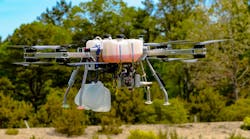MIT reports on an invention from a startup founded by one of its alumni—a hybrid gas-to-electric drone that can support heavier payloads and operate longer than battery-powered UAVs. The research team says that their technology may be paving the road toward human flight, and will fill market needs in e-commerce delivery and cargo transport.
The inventor, Long Phan PhD, created the company Top Flight in 2014 to develop and commercialize hybrid power systems for drones. It began as a spin-off to a research project at the university, but now the company announces that it will release its first heavy-duty drone design this fall.
The drone can carry a 20-lb. payload over 2.5 hours for up to 100 miles. It uses an internal combustion engine that weighs 17 pounds and generates up to 10 kilowatts power. The engine power the drives to the lift motors and keeps the battery and on-board electronics charged. Though the tank requires refilling, the hydrid design saves time on charging.
“The key is having an abundance of power and total energy. That’s what petrol and gasoline gives you,” Phan says. “Using a high-energy-density energy source like gasoline, and converting it to electric power, and doing it efficiently, gives you the equivalent of a ‘super battery.’”
Phan founded Top Flight in 2014 with his former advisor, Sanjay Sarma and other MIT engineers. He continues to hire MIT alumni and other staff. Future company plans are to build a 100-kilowatt hybrid drone that can lift 100 kg.
Design challenges come with creating a drone that is light enough to fly while producing enough power to carry heavy loads. The current drone at Top Flight uses an internal combustion engine, but Top Flight intends to use a hybridized gas turbine engine for its next design. This will require more changes to the design, including new systems for heat transfer and vibration damping, but is expected to increase the overall efficiency for better performance.

